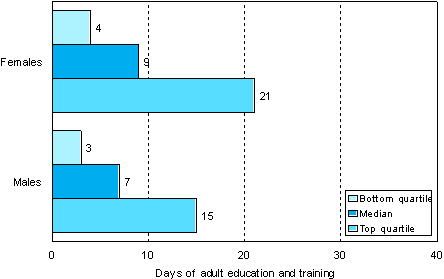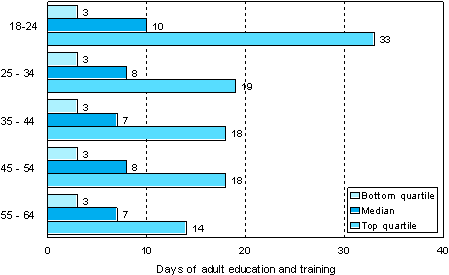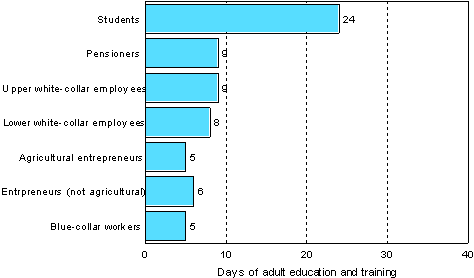1.Average number of received days of adult education was eight
In 2006 some 1.7 million Finnish residents, or every second person aged 18 to 64, participated in adult education and training. However, the extent of education received, that is the number of days in adult education and training varied considerably. One-half of the participants in adult education and training in 2006 had received at least eight days of education and training (median). A rather large part of the participants had, however, received only little education and training; ten per cent of the participants in adult education and training studied for only one day and one-fourth studied at most three days (bottom quartile). By contrast, the quartile who participated in adult education for the longest studied for at least 19 days (top quartile) in 2006.
Women were more active in participating in adult education and training, and they also received more days of it. The median of the study days was nine for women and under seven for men (Figure 2). The difference between the genders was particularly clear among the quartile who participated the most; the women among them had at least 21 days in education and training while the corresponding number for the men was only 15 (top quartile). Men’s days of adult education and training have decreased clearly from the year 2000 to the year 2006, which has resulted in a clearer than before difference between women and men.
Figure 2. Number of days of adult education and training per participant by gender in 2006 (participants aged 18 to 64)

Young people aged 18 to 24 received more days of adult education and training than persons belonging to older age groups (Figure 3). One-half of the persons aged under 25 having received adult education and training in 2006 had received at least ten days of education and training, while the corresponding median of training days in the other age groups was 7–8. Persons aged 55 or over had the least days in education and training.
The above figures include also full-time students and their days of adult education and training. When examining the number of training days without students, the average number of training days among the 18 to 24-year-olds falls to the level of the whole population, that is, to 7 days. The top quartile also falls to 25 days.
Differences between age groups have evened out somewhat from the year 2000. This is due, for a large part, to the fall in the number of days of education and training especially among people who have many training days (in practice the top quartiles and averages of days of education and training have fallen). Large numbers of days of education and training were rather rare in both survey years.
Figure 3. Number of days of adult education and training per participant by age in 2006 (participants aged 18 to 64)

As the examination by age illustrated, full-time students took use of clearly more days of adult education and training services than persons belonging to other socio-economic groups. Every second participant had received at least 24 days of adult education and training during the past year (Figure 4).
The smallest number of days of adult education and training was recorder among entrepreneurs, both agricultural and other entrepreneurs, as well as blue-collar workers. In these groups every second participant had received an average of 5–6 days of education and training. Pensioners as well as upper and lower white-collar employees received some 8–9 days of adult education and training in 2006. Their participation is well illustrated by average participation days: the quarter which received the least education and training had received at least 3–5 days (bottom quartile) and the quarter which received the most education and training had received at least 16–20 days (top quartile) during the past 12 months.
Figure 4. Average number of days of adult education and training (median) per participant by socio-economic status in 2006 (participants aged 18 to 64)

In 2006 highly educated persons continued to receive the most adult education and training, but the differences between educational groups in the amount of received adult education and training has diminished when compared with the year 2000. The median number of days of education and training varied between 7 and 9 in all educational groups, and every fourth person had received at least 18 to 19 days of adult education and training or training during the 12 months prior to the inquiry. In 2000 every second person with tertiary level qualifications spent at least 10 days in adult education and training. The respective number of days in adult education and training among persons with primary or lower secondary level education was six.
The unemployed and persons outside the labour force who participated in adult education and training received, on average, clearly more days of education and training than the employed. One-half of the participants in adult education and training who are outside the labour force received 14 days of education and training (median). On the average, the unemployed received 11 days and the employed 7 days of education and training. The top quartiles of days of education and training for those outside the labour force and the unemployed were 48 and 40 days, whereas the top quartile for employed persons who received education and training was just 15 days.
The numbers of days of adult education and training show very little variation when examined by the respondents’ place of residence. Persons living in semi-urban areas and in the Province of Western Finland spent one day less in education and training (median 7 days) than persons living in urban or rural municipalities or in the other provinces (median 8 days). In urban municipalities the quartile with the most education and training had at least 20 days of, whereas in semi-urban municipalities the days of education and training numbered somewhat less, or 15 days. By contrast, differences between different municipality groups were not evident when examining average numbers of days of education and training and their standard errors. In the Province of Western Finland the average number of days of adult education and training was statistically smaller than in the Provinces of Eastern Finland and Oulu.
The medians of days of adult education and training were the same in 2000 and 2006. By contrast, when examining the average amount of received adult education and training with the help of the average number of days, we see that the number of days of adult education and training has decreased slightly from the year 2000 to the year 2006. In 2000 the average number of days of education and training was 25 per participant, while six years later the corresponding number was only 21 days.
When estimating the averages for days in education and
training the media as well as top and bottom quartiles have been
used instead of the arithmetic average as the dispersion of days in
education and training is large and the distribution is strongly
skewed. For the purpose of calculating key figures, the data are
ordered by magnitude in terms of days in education and
training.
Median represents the middle value in the data.
Bottom quartile represents the value under which 25 per cent of the
observations fall.
Top quartile represents the value under which 75 per cent of the
observations fall.
Source: Adult Education Survey 2006, Statistics FinlandAikuiskoulutustutkimus 2006, Tilastokeskus
Inquiries: Kirsti Pohjanpää (09) 1734 2604, Helena Niemi (09) 1734 2488, Timo Ruuskanen (09) 1734 3620
Director in charge: Riitta Harala
Updated 31.12.2008
Official Statistics of Finland (OSF):
Participation in adult education [e-publication].
ISSN=2489-6926. Duration and content of education and training 2006,
1.Average number of received days of adult education was eight
. Helsinki: Statistics Finland [referred: 8.1.2026].
Access method: http://stat.fi/til/aku/2006/02/aku_2006_02_2008-12-31_kat_001_en.html

